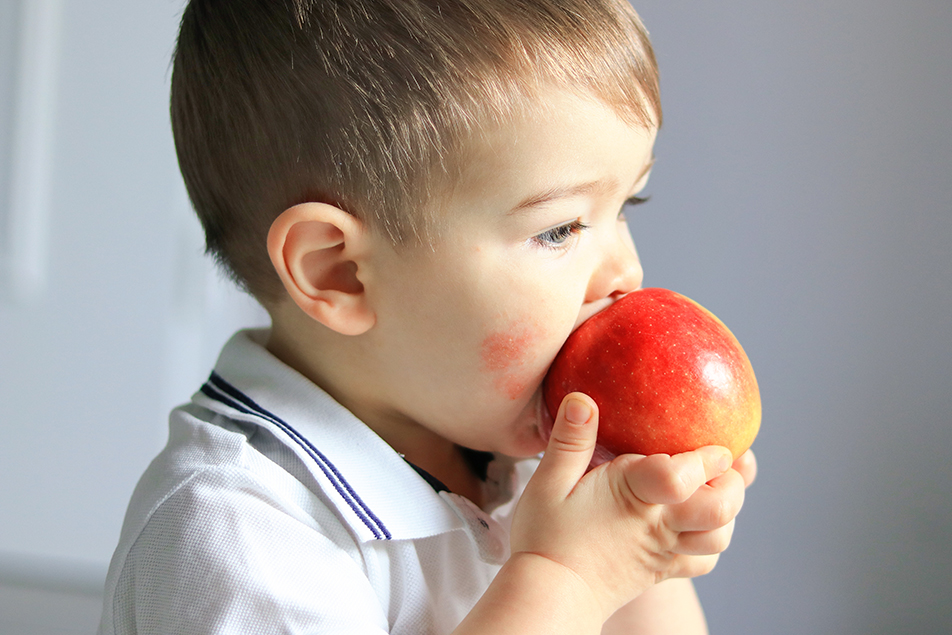
For parents navigating the chronic skin condition eczema with their child, it’s important to be aware that they could also have an increased risk of developing food allergies. Diana Munoz-Mendoza, MD, PPG – Allergy, Asthma & Immunology, talks about getting the right diagnosis and watching for additional warning signs and symptoms.
What is eczema?
Eczema is a chronic skin condition that causes itchiness, rashes, dry skin and skin infections. There are different types of eczema, however, the most common is atopic dermatitis and for this reason, these terms are frequently used interchangeably.
Atopic dermatitis (eczema) usually affects kids, commonly presenting in the first weeks or months of life. It can also start during childhood or in adulthood.
Eczema results from an overactive immune system, and there are multiple contributing factors, including genetic predisposition and interaction with an individual’s environment. ?
How can a parent determine if their child has atopic dermatitis?
Most often, atopic dermatitis looks like red, dry, and scaly skin, that’s typically very itchy. This itchy skin can lead to skin infections from excessive scratching.
The condition can occur on any part of the body, but there are certain areas where it is most common in relation to a patient’s age. For example, in babies, it affects their scalp, cheeks, body and the external surface of their arms and legs. In toddlers and older children, the eczema rash is often in the skin creases – behind the knees, neck, on wrists, elbows, and ankles.
Eczema is sometimes confused with other skin diseases, so it’s important to get a diagnosis from a physician. Allergists and dermatologists are qualified healthcare professionals who have expert knowledge on the diagnosis and treatment of eczema. Parents should also know that eczema is not contagious.
Is atopic dermatitis associated with food allergies?
Atopic dermatitis is considered a major risk factor for the development of food allergies. There are two different forms in which foods can affect children with eczema. The first is an immediate reaction after eating a food, urticaria/anaphylaxis. The other, food-exacerbated atopic dermatitis, can take hours or even days to induce a reaction.
If a patient experiences urticaria (hives) and anaphylaxis, symptoms will occur within minutes of eating a food. Anaphylaxis is a severe, potentially life-threatening allergic reaction that affects several systems in the body.
With food-exacerbated atopic dermatitis, ingesting certain foods causes a worsening of the redness or itchiness of the lesions. The flare up occurs within minutes to a few hours, but it can take few days to develop.
Many infants with atopic dermatitis also develop other allergic diseases, like asthma and/or allergic rhinitis, later in childhood.
Will food allergies make atopic dermatitis (eczema) worse?
Not all children have atopic dermatitis that is exacerbated by foods. We suspect it in small kids (usually below the age of 5) when it is severe or when there are not periods of clear skin. Infants may have additional symptoms that suggest food allergies, like vomiting, diarrhea, or poor weight gain.
When a food is suspected to be a trigger, it's important to see an allergist and obtain an accurate diagnosis. Your child’s allergist may request food allergy testing, and he/she may ask you to do a trial of avoidance of the suspected food to confirm the diagnosis. Given the high rate of food sensitization, the diagnosis of food allergies in children with eczema requires the expertise of an allergist. Sensitization to foods can result in a positive blood or skin test, but no food allergy.
Parents should not avoid foods unnecessarily, because doing so can have serious implications like nutritional deficiencies or poor growth for the child.
What are some treatments for eczema?
The treatment of eczema depends on its severity, and includes moisturizing of the skin, topical steroids, and other injectable medications. Work with your provider to develop an effective treatment regimen.



